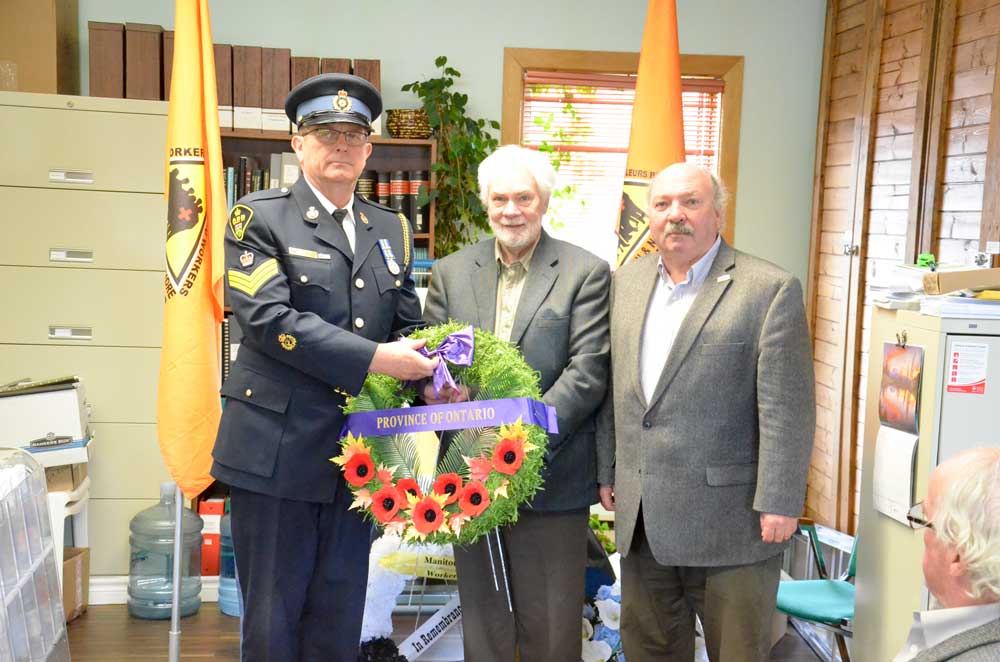AUNDECK OMNI KANING—A small and sombre group of Island elected officials, union representatives and organization heads joined members of the Manitoulin Injured Workers Group (MIWG) for an April 28 candlelight memorial observance of the National Day of Mourning held in the board room of the Manitoulin Legal Clinic. The National Day of Mourning is held each April 28 to remember those who have died, were injured or made ill from their work and to make the commitment to protect workers and to prevent further workplace tragedies.
“Today being the National Day of Mourning, there are many observances taking place,” said Colin Pick, master of ceremonies for the afternoon. “This is the fifth year this ceremony is being held on Manitoulin Island.”
Mr. Pick called for the recognition of Northeast Town Mayor Al MacNevin and Central Manitoulin Mayor Richard Stephens, as well as Manitoulin OPP Detachment Commander Staff Sergeant Kevin Webb, MIWG President Gary Hrytsak, UNIFOR rep Kevin Bailey and Pastor Martin Garniss, thanking them for their attendance at the memorial.
Manitoulin Legal Clinic Executive Director Mike Shain was the first speaker and he recalled one of the most shocking revelations he found while reading the book ‘Working Class War,’ a book on the American involvement in the Vietnam War. “Same number of soldiers died in 1968, the year of highest casualties in the Vietnam conflict,” he said. “There were 100,000 people dying each year from industrial accidents and diseases.” The Vietnam War casualties resulted in massive protest marches and opposition, yet for those lost to workplace tragedy there was, and continues to be, “relative silence.” He was left wondering about the worth placed on workers’ lives—“there have never been nation-wide protests, workers’ names have never been inscribed on a black granite monument. You are left with the impression that workers’ lives don’t matter, they don’t count—if they did matter they would continue to die.”
Although politicians are often heard to utter words of support and assurances that they have passed laws to protect workers “it obviously has not been enough, workers continue to be injured and killed in the workplace.”
Mr. Shain called for a national inquiry into why so many workers continue to be killed on the job. “These are not numbers in the abstract,” he said. “These are fathers and mothers, these are our brothers and sisters, our children—not lines on the spreadsheet denoting the cost of doing business. We need to understand that there are things in our society that need to be fixed.”
MIWG President Hrytsak recalled the working life of his father, who passed at age 95 in relatively robust health. “He took care of himself,” he said, noting that in the days before hearing protection equipment, his father and co-workers would stuff wet toilet paper wads into their ears to ward off the impact of the loud industrial machinery.
In conversation following the official statements, President Hrytsak noted the challenge that organizing injured workers into an effective lobbying voice has proven daunting, made even more challenging by a social reticence to push back against the system and an odd reluctance of people to recognize that it could so easily happen to them or their own loved ones, but that something has to be done. “We go to work to earn a living,” he said. “We don’t go to die.”
UNIFOR rep Mr. Bailey spoke of some of the industrial issues that he has faced locally, including the propensity for industrial companies to pressure employees to not file WSIB (Worker’s Safety Insurance Board) claims when injured and to retaliate when they do.
“But we have seen it so many times; a company pays an injured worker their wages while they are off injured, but then later, when the consequence of that injury comes back, the company has gone bankrupt, moved on, and the worker is left without recourse,” he said. Mr. Bailey said that such abuse of authority is all too commonplace and needs to be stopped. Too often in the past both a company and the union representing their workers have been complicit in preventing the filing of claims.
Staff Sergeant Webb said that it was “humbling to be a part of this important event, remembering those who lost their lives as a result of workplace incidents, also the many individuals who have suffered injuries which altered their personal and professional lives. No one goes to work with the intention of not coming home safely at the end of the day,” he stated.
Staff Sergeant Webb noted that, in his capacity as a police officer, “specifically when I was a detective, I investigated serious injury and death occurrences related to the mining industry, the logging industry, construction industry, commercial transport industry and, of course, emergency services employees.” All of the victims in these cases had intended to come home safely to their families.
The staff sergeant took the opportunity to memorialize fallen officers, in particular Constable Lloyd Lackey. Although he did not personally know Const. Lackey, who died in 1972, he did have the opportunity to meet some of his family during a bridge dedication ceremony held not far away from where that day’s ceremony was being held. Constable Lackey was killed while returning from a domestic call. Travelling down Highway 540 late at night an oncoming car swerved into their lane. Although his partner survived the head-on collision, both Const. Lackey and the driver of the other car were killed.
Today, Const. Lackey’s name graces the OPP Wall of Honour at its headquarters, but is also memorialized by the bridge over Graham Creek in Honora on Highway 540, dedicated to his memory in a ceremony held in August, 2013.
Staff Sergeant Webb said it was “very gratifying for me to see that we have events such as this to recognize and remember all those who lost their lives or made significant sacrifices through serious injury in the workplace.” He went on to publically thank the organizers of the memorial event and family members of those who lost their lives for allowing him the opportunity to honour their loved ones. He concluded his remarks by saying “we will not forget.”
Mayor MacNevin and Mayor Stephens together lit a candle in memory of the fallen on a table decked with icons of the mining industry, including a vintage mining helmet, an old miner’s lamp and a canary cage (symbolizing the canary in the coal mine concept, where miners would use a canary as an early warning of poison gas).
Pastor Martin Garniss read out the names of the Manitoulin Island workers who had been lost to workplace injuries and members of the MIWG who had passed on in the last year (five).
MIWG member Herne Steelgrave noted that the organization is not just a group that deals with injured workers, but is also a support group and he urged those suffering from the isolation of workplace injury to reach out to the group.





